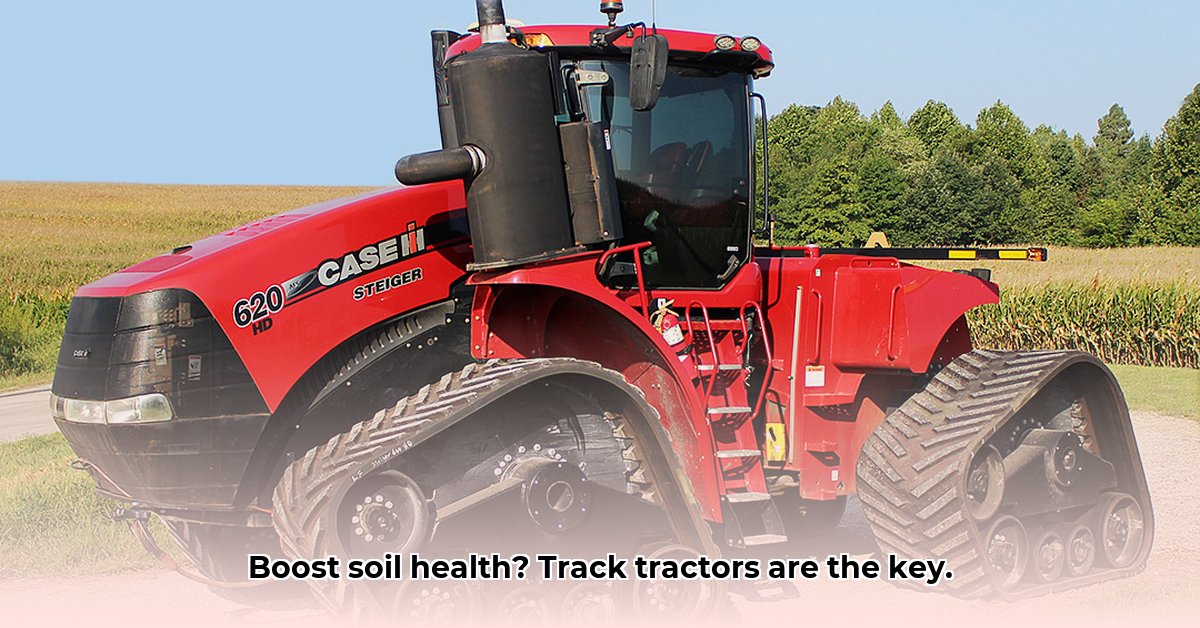
Soil compaction, a major obstacle to sustainable agriculture, significantly reduces crop yields and hinders environmental stewardship. But what if a simple change in machinery could revolutionize farming practices? This article explores the potential of quad-track tractors—a technology promising to bolster soil health and enhance sustainable farming practices. We'll examine the advantages and disadvantages, providing actionable insights for farmers, manufacturers, and policymakers. For more information on Case IH tractors, visit the Case IH website.
Case Tractors with Tracks: A Detailed Analysis
The Case tractor with tracks presents a compelling alternative to traditional wheeled tractors, particularly concerning soil health. Unlike wheeled tractors which compact soil, reducing water infiltration and root growth, tracked tractors distribute weight more evenly, minimizing soil compression. This results in healthier plants, improved yields, and potentially reduced reliance on chemical fertilizers and irrigation, ultimately contributing towards a more sustainable farming model.
Advantages of Tracked Tractors: Sustainable Farming's New Frontier
The primary benefit of tracked tractors is their reduced soil compaction. Studies show a significant decrease in soil compression compared to wheeled tractors, leading to improved root growth, water infiltration, and nutrient uptake [1]. This translates to healthier plants and higher yields. The improved traction also results in greater fuel efficiency. Less slippage means less wasted fuel and reduced wear and tear on the machinery, offering further economic advantages [2]. The reduced soil disturbance also minimizes topsoil erosion, preserving its vital structure and contributing to long-term soil health.
Challenges and Drawbacks: A Balanced Perspective
Despite the advantages, challenges exist. The high initial purchase price is a significant barrier to entry for smaller farms with limited budgets. This makes financial viability crucial for widespread adoption. Additionally, long-term environmental data is limited, necessitating further research to fully assess their impact. Limited market availability in certain regions could also create challenges regarding access to spare parts and skilled mechanics. A robust risk assessment is crucial.
Understanding the Risks: A Risk Assessment Matrix
| Risk Factor | Likelihood | Impact | Mitigation Strategies |
|---|---|---|---|
| High initial purchase price | Moderately High | High | Explore leasing or financing options; seek government subsidies; consider farm cooperatives |
| Limited long-term data | High | Moderate | Actively seek out and review ongoing research; participate in data-sharing initiatives |
| Technical malfunctions | Low | Moderate | Invest in comprehensive warranties; establish a robust maintenance schedule; engage a skilled mechanic |
| Parts availability | Moderate | Low to Moderate | Identify trusted suppliers; develop relationships with parts distributors |
| Learning curve for operation | Moderate | Low | Attend training courses; utilize online resources and manuals; seek guidance from experienced operators |
Actionable Steps for Different Stakeholders: A Collaborative Approach
The successful integration of tracked tractors demands a collaborative effort:
Farmers (Small and Large Scale):
- Financial Planning: Explore leasing, loans, or government subsidies to offset initial costs. Conduct thorough cost-benefit analyses, considering long-term soil health improvements and potential yield increases.
- Precision Agriculture: Integrate GPS-guided technology to optimize tractor utilization and minimize fuel consumption.
- Soil Health Monitoring: Regularly monitor soil health indicators to assess the effectiveness of tracked tractors. This provides valuable data for future decision-making.
- Knowledge Sharing: Share experiences and data with other farmers to promote best practices and build a collective understanding.
Manufacturers (like Case IH):
- Affordable Financing: Offer flexible financing options to make tracked tractors more accessible.
- Transparent ROI Data: Provide compelling data illustrating the long-term financial returns of tracked tractors.
- Lifecycle Research: Invest in research to thoroughly assess the long-term environmental impact.
- Improved Design and Durability: Focus on improving track longevity and developing efficient repair protocols.
Governments:
- Financial Incentives: Provide targeted subsidies and tax breaks to encourage the adoption of sustainable farming technologies.
- Research Funding: Increase funding for research into the long-term environmental and economic impacts of tracked tractors.
- Educational Programs: Implement educational programs to train farmers on the operation and maintenance of tracked tractors, increasing adoption rates.
- Supportive Regulations: Consider regulations that promote technologies that actively reduce soil compaction and improve overall environmental sustainability.
The Future Outlook: Continued Research and Collaboration
The long-term impact of quad-track tractors remains an area requiring further research. While the initial findings are promising, extensive long-term studies are needed to fully understand their environmental and economic viability across various farming systems. This includes developing standardized methods for measuring soil health and environmental impact. Collaboration between all stakeholders will be crucial in optimizing this technology and realizing its full potential within sustainable agriculture.
[1]: Insert citation for reduced soil compaction study here [2]: Insert citation for fuel efficiency study here